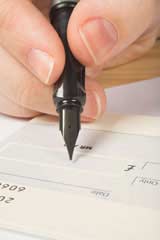Using Your Cheque Book

Having been around since the early days of 1659, the cheque could soon have vanished from sight as plastic takes over.February 2008 saw the Payments Council, the official body that responsible for the strategies of UK payments, decide whether or not they should step in to help manage the decline of the cheque.
Highstreet stores, such as Tesco, Marks and Spencer, ASDA, Curry's Next and PC World, have all banned the use of cheques by customers and insisting on cash or plastic as way of payment. It is claimed by these, and many more retailers, that they are simply responding to the customer's preference to use chip-and-pin service because of its speed and convenience.
Recent figures from Apacs revealed that, in fact, only 4 per cent of retail spending is carried out by cheque, in comparison to 60 per cent on plastic.These trends have been given a push by the popularity of internet banking and online shopping, along with the ease of direct debit payments.
It is also becoming more apparent that, in a bid to reduce their carbon footprints, many large firms such as BT now charge for those customers who choose to pay by cash or cheque.
The concern here is that the older generation who have come to rely on this paper payment method will get left behind.
According to Apacs, there are only a handful of countries left that still use cheques as a form of payments, including France, Italy and of course the UK and Halifax has predicted that by 2025 cheques will be extinct.
The History of the Cheque
During the English Civil War, 1642-1651, the goldsmith's safes were secure places for the deposit of jewels, bullion and coins. Instructions to goldsmiths to pay money to another customer subsequently developed into the cheque. Similarly goldsmiths' receipts were used not only for withdrawing deposits but also as evidence of ability to pay and by about 1660 these had developed into the banknote.
The 'cheque' may have been around since 1659, but the first official chequebook was actually issued by the Bank of England in 1830 and even then, cheques didn't start to circulate widely until the late nineteenth Century.
It was in the 1960's that there was a marked increase in the number of bank account holders once cheque guarantee cards were introduced.
However, it was in the 1990's when the cheque reached its most popular with over 11 million being issued each day - a figure that has now been reduced down to a mere 4.9 million and is expected to decline rapidly over the next eight years.
Of course, lets not forget that the chequebook was also one of the most famous consolation prizes - The Blankety Blank chequebook and pen was of course just a fancy silver trophy in the shape of a chequebook.
A cheque is a written order by an account holder to his banker to pay a specified sum of money to the bearer or named recipient. A cheque is not legal tender but it is a legal document, the use of which is governed by the Bills of Exchange Act 1882 and the Cheques Acts of 1957 and 1992.
- Does the Taxman's Latest Blunder Affect You?
- Shattering the Banking Myths
- Why Banks Are Failing the Socially Disadvantaged
- Why Are Cheques Being Phased Out?
- Is Metro Bank the Answer for Frustrated Customers?
- Using Your Bank Overdraft Wisely
- Your Banking Questions Answered
- Getting the Most from Your Bank Account
- How To Choose Which Bank is Right for You
- Changing Your Current Account
- BACs Transfers and Processing Explained
- Choosing a Business Account
- Packaged Current Accounts Explained
- Online Current Accounts
- Basic Bank Accounts Explained
- Choosing a Current Account


Re: Can My Friend Pay His Cheque into My Account?
My son has received a UK cheque for £10, but now lives in Germany, and no longer has a UK bank account. Can…
Re: Can My Friend Pay His Cheque into My Account?
Iv had a tax payment I was owed I havnt got a bank account how can I cash my money
Re: Can My Friend Pay His Cheque into My Account?
I have received car refund cheques from DVLA as my name. Can I pay into my friends bank account as I don’t…
Re: Are Business Accounts Protected if Banks get into Difficulty?
I belive the famount guaranteed is £ 86, 000 not £ 50,000 that you mentuion. Can you…
Re: Can My Friend Pay His Cheque into My Account?
I have received a check in my mums name can I put it in my account as my mum passed away on October 15
Re: BACs Transfers and Processing Explained
Can a Bacs payment be made into a deposit account?
Re: BACs Transfers and Processing Explained
I was supposed to have funds from a sale of a mobile home from the management to be paid to me by BACS - they ve…
Re: BACs Transfers and Processing Explained
Our family solicitor transferred a share of my Aunts estate via BACS to my account, it has been placed as pending…
Re: BACs Transfers and Processing Explained
Can I receive self employed grant into my savings account
Re: Can My Friend Pay His Cheque into My Account?
Can my frend pay a. Cheque in in for me as I can't get to. The bank myself